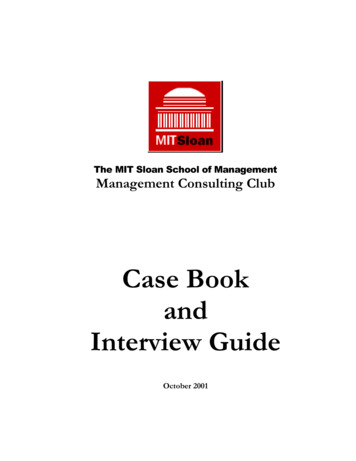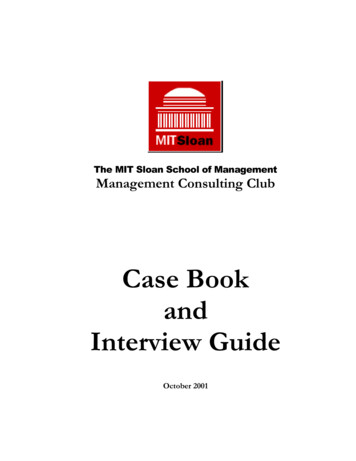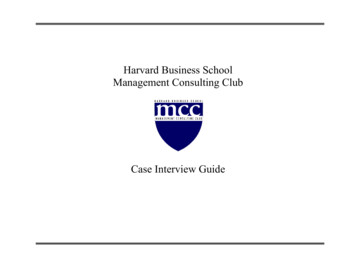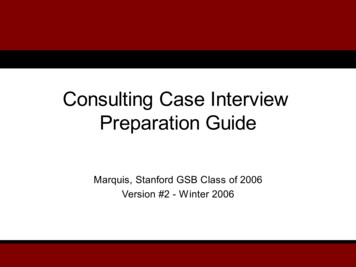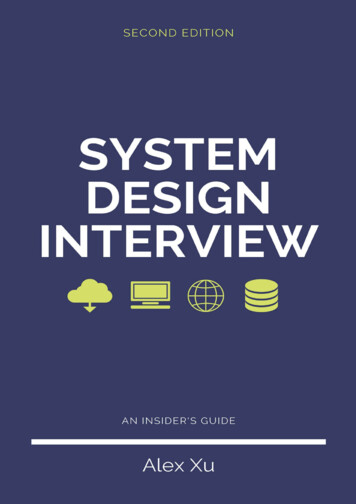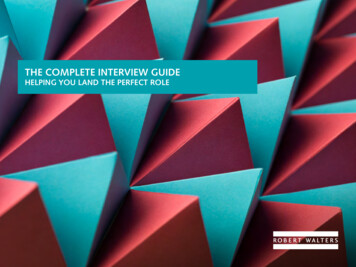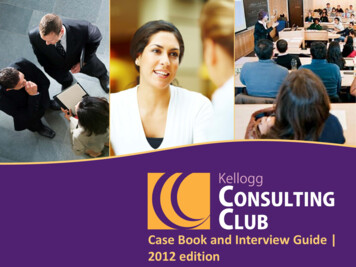
Transcription
Case Book and Interview Guide 2012 edition
Kellogg Case Book – 2012 EditionThis book was originally written, edited, and designed by:Adam J. Louras (Kellogg Class of ‘11)Ameed Mallick (Kellogg Class of ‘12)Uri Kalir (Kellogg Class of ‘12)Peter Manoogian (Kellogg Class of ‘12)Craig DePriester (Kellogg Class of ‘12)Mauricio Atri (Kellogg Class of ‘12)This book was, edited and refined in 2011 by:William Bate (Kellogg Class of ‘12)James Han (Kellogg Class of ‘13)Mitchell Reiman (Kellogg Class of ‘13)Marcelo Rodriguez Sada(Kellogg Class of ‘13)Travis Meyer(Kellogg Class of ‘13)Sushant Khandelwal (Kellogg Class of ‘13) If you have question or concerns please write to Sushant Khandelwal at:skhandelwal2013@kellogg.northwestern.eduThis book is intended for internal use by members of the Kellogg Consulting Club (KCC). Distribution to individuals outside ofthe KCC is forbidden without express written consent by KCC.Copyright 2012 by the Kellogg Consulting Club. Copyright Act of 1976, no part of this publication may be reproduced ordistributed in any form or by any means, or stored in a database or retrieval system, without the prior written permission ofthe publisher. 2012 Kellogg Consulting Club -- All Rights Reserved2
Consulting Calendar ulting Recruiting TimelineAtrium Hours/ Presentations/Coffee ChatsExam Prep sPreparation ProcessPhase I:Marketing YourselfPhase II:Office Selectionand FitPhase III:Fit & BusinessAcumenPhase IV:Case PrepPhase V:Crush InterviewsYou Are HereThis document contains sample materials to use to prepare for interviews 2012 Kellogg Consulting Club -- All Rights Reserved3
ContentsHow to use this bookCase formats: what to expectTypical case flow and evaluationFit interview tipsKCC 2012 casesIndustry overviews and appendix 2012 Kellogg Consulting Club -- All Rights Reserved4
Using the case bookTips for effective pre- and post-case activitiesInterviewer (delivering case)Interviewee (receiving case)After the caseBefore the case Ask the interviewee if they wish tofocus on specific:––– Inform your interviewer if you havespecific areas for improvement Confirm that you have not previouslydone the case your interviewer isplanning to deliver DO NOT read the case ahead of time ordiscuss the case contents with peers! Bring plenty of paper to take notes!Case formats / conceptsLevels of difficultyIndustries Inform interviewee which case youplan to deliver to confirm they haveno prior knowledge of the case Spend at least 30 minutes to reviewthe case Provide detailed feedback (bothpositive and constructive) tointerviewee in a timely manner Seek feedback from the intervieweeon your case delivery 2012 Kellogg Consulting Club -- All Rights Reserved Provide detailed feedback (bothpositive and constructive) tointerviewer in a timely manner Seek feedback from the intervieweron your case performance Log your performance in the “casetracker”5
The title page for each case contains details that willinform case selectionUsing the case bookOverview of case title page24131Case tracker:2Status bar:3Guide to interviewer:4Fit questions:Provides overview on case including industry, format, and conceptstestedIncludes ratings for quant intensity and structure (1 lo, 10 highest), as well asindustry logo, case format, and concepts testedContains the overview of the case and allows users to determinewhether they should give the case based on its attributesContains 3 fit questions to begin the interview. After fit, then ask the casequestion 2012 Kellogg Consulting Club -- All Rights Reserved6
Using the case bookThe “Clarifying answers” page contains supplementalinformation and a suggested guide to the case’s flowOverview of clarifying answers and case guide page121Clarifying answers:Contains information that is NOT relevant to the main solution path. This is forsupplementary information such as: “we do not know the competitive dynamics”or “the market has been growing at GDP.”2Guide to case:Lays out the ideal structure for the case and includes hints on how to walk throughthe interview/handouts, as well as when to show them to the interviewee. 2012 Kellogg Consulting Club -- All Rights Reserved7
The “Key elements to analyze” page contains theanalysis of the key case conceptsUsing the case bookOverview of key elements to analyze page121Concept box:Includes the key question or objective associated with a main case concepttested. The interviewee should naturally move to asking or addressing theinformation in this box, but you may need to provide a little “push” at times.2Notes to interviewer:Contains additional information that you may provide to the interviewee duringan investigation of the particular case concept. This information isCRITICAL to the interviewee solving the case both numerically and conceptually. 2012 Kellogg Consulting Club -- All Rights Reserved8
Using the case bookIndustry logosThe following logos will be located underneath the quant/structurescores on the case title page to indicate the industry being coveredFinancialServicesShipping onsumerProductsTravel &LeisureTech &TelecomCPG 2012 Kellogg Consulting Club -- All Rights Reserved9Media &EntertainmentOtherHealthcare
ContentsHow to use this bookCase formats: what to expectTypical case flow and evaluationFit interview tipsKCC 2012 casesIndustry overviews and appendix 2012 Kellogg Consulting Club -- All Rights Reserved10
Using the case bookCase Formats VaryThe following represent the most common case formats on which acase interview will be based (ranked in descending order of frequency)FormatFocusProfit improvementAnalyzing causes for recent drop in profits / ways to increase profitsMarket entryAnalyzing a firm’s opportunity to expand into a new business or segmentOpportunity assessmentExamining the potential purchase / sale of a new or existingbusiness or installation / abandonment of an infrastructureIncreasing salesIdentifying ways in which a firm can optimally increase salesMerger / AcquisitionEvaluating whether a firm should merge or purchase another companyMarket sizingDetermining the size, usually in terms of a firm’s revenue potential, of a marketIndustry analysisEvaluating an industry’s structure and/or desirabilityStarting a new businessSimilar to entering a new market; then taking an investment point of viewGrowth strategiesDetermining the optimal ways to grow a companyDeveloping a new productAssessing a new product offeringReducing costsIdentifying internal or external costs that are out of lineCompetitive responseEvaluating ways to address a competitor’s action (e.g., new product launch)TurnaroundsGathering info on why company is failing and then suggesting corrective action 2012 Kellogg Consulting Club -- All Rights Reserved11
Using the case bookBroad Range of Business Concepts EvaluatedEach case will follow a specific format and cover multiple business conceptsBusiness ConceptsQuantitative focusQualitative focusAccountingCustomer strategyBasic NPVCompetitive analysisBreak-even analysisCreativityCapacity expansion/ContractionOperationsElasticityMarketing strategyInvestmentsOrganizational changesMacroeconomicsPricing strategyMarket shareSupply/value chainMarket sizingVertical integrationMicroeconomicsBrain teaser 2012 Kellogg Consulting Club -- All Rights Reserved12
ContentsHow to use this bookCase formats: what to expectTypical case flow and evaluationFit interview tipsKCC 2012 casesIndustry overviews and appendix 2012 Kellogg Consulting Club -- All Rights Reserved13
A Typical Case Flow5-10min20-30min5 minIntro & FitInterviewCase InterviewWrapUp/Q&A5 -10 min1Structure theproblem Clarify question Structurethoughts/ drawissue tree Don’t useframeworks15 min2DevelopHypothesis543Deep DiveDevelopSolution Use structure toprobe the case Deep dive into 1or 2 areas Ask ‘so what?’to develop soln. Develop ahypothesisbased on datapoints Bequantitativelyoriented Be prepared tostress test soln./assess risks Link differentdata points Be creative Be MECE 2012 Kellogg Consulting Club -- All Rights Reserved145 minSynthesize Summarizerecommendationfor client Focus on answer,not process/methodology
Key Skill Tested:Structured Thinking, Business JudgementStructure the Problem1Structure theproblem DevelopHypothesisDeep DiveDevelopSolutionGet the case facts right – ask clarifying questionso Especially the objective: E.g. if interviewer say that objective is tobe market leader in 5 years; clarify what does it mean – 20%share or 65M revenues etc. Do not just repeat what the interviewer said Take a minute or so to draw the structure Structure:o Two levels of structure – broad bucket and sub bucketo Draw out a tree rather than bullet pointso Customize the structure to the case, don’t use frameworkso Be MECE Turn the paper around to show the structure 2012 Kellogg Consulting Club -- All Rights Reserved15SynthesizeSolve the rightquestion?Don’t force fitframeworks
Key Skill Tested:Hypothesis driven, PrioritizationDevelop Hypothesis2Structure theproblemDevelopHypothesisDeep DiveDevelopSolution Refer to your structure throughout the analysis Prioritize your thoughts by forming a hypothesiso Use the info provided and any clues from the interviewero Use your framework and info to form your initial hypothesis Don’t feel pressured to form hypothesis without enough datao Sometimes the answer is less obvious - you may have to dig a bit first Organize your investigation per your structureo Organizing analyses in sections may be beneficial (paper mgmt)o Gives interviewers a chance to help you if you go astray Engage with the interviewer 2012 Kellogg Consulting Club -- All Rights Reserved16SynthesizeUse data to formhypothesis –remember 80-20Be flexible; don’tbe married to yourinitial structure/hypothesis
Deep dive into 1 or 2 areasKey Skill Tested:Quantitative Skills, Business Judgment3Structure theproblem DevelopHypothesisDeep DiveDevelopSolutionOrganize as ‘slides’o E.g. separate pages for revenue analysis, cost analysis, profit analysisLink together various data pointso Don’t just look at each data set independentlyLayout quantitative data “Excel-style” / in tables when possiblePublic Math – be aware of what the end goal iso Show your calculationso Talk through your matho Practice will make discomfort with math disappearCommon facts: Brush up figures for US population 2012 Kellogg Consulting Club -- All Rights Reserved17SynthesizeSetup theequation/process first
Key Skill Tested:Creativity, ConfidenceDevelop Solution4Structure theproblem DevelopHypothesisDeep DiveBe sure to ask the ‘so what’ questionso Don’t just state the obviousDevelop creative solutions – think out of the boxo Pressure test your solutiono If you think the goal is not achievable thensuggest alternativesAlways consider implementation implications, risksand mitigationUtilize your analysis to make a powerful statement– take a stand, don’t hesitateAlways end your case with a succinctrecommendation 2012 Kellogg Consulting Club -- All Rights Reserved18DevelopSolutionSynthesizeA good solution is:1. Best amongalternatives2. Practical3. Based on facts
Key Skill Tested:Ability to synthesizeDevelop Solution5Structure theproblem DevelopHypothesisDeep DiveDevelopSolutionTake a moment to prepare your thoughtso Again, ask permission to do so and keep it briefo Be prepared for the “elevator test” Highlight main points as you go through the analysisto facilitate a concise summaryProvide the answer to the question firstThen talk through the reasons behind the answerDon’t focus on the process or methodology you followed 2012 Kellogg Consulting Club -- All Rights Reserved19Synthesize‘ExecutiveSummary’ Style
Case prep scoring: Provide tangible points thatcan be practiced and improved1.- General feedbackCase oodStrongQuantitative: comfort with complex math; shows math and logically lays out dataQualitative: conveys understanding of big picture takeaways; realistic thinkingCreative: identifies different approaches to solve the problemCommunication: strong listener, openly shares thought process, good body language2.- Case specific FeedbackClearly understands and defines the problem/question; breaks problems intocomponentsPrioritizes analysis; Identifies critical path to the recommendation and most importantissuesProvides a structured and thoughtful approach to solve the problem (e.g. draw issuetree with critical pieces of analysis)Summarizes key findings through the solution of the case and translates them intoinsights or important takeawaysPragmatic/ realistic solution that answers the initial question with supporting evidenceAssesses risks and consequences for the recommendation; identifies key next stepsto further prove the solution 2012 Kellogg Consulting Club -- All Rights Reserved20
Case scoringEvaluation criteria (1/2)Case skills and driving the caseCommunication skillsProblem definition: Clearly understands and defines theproblem/ questionStructure: Shares thinking process throughout the case andaligns his communications with the structure of the caseProblem breakdown: Breaks problem into most importantcomponentsFocus: Highlights key insights, important findings and criticalissuesStructure: Uses a structured and thoughtful approach to solvethe problem (e.g. draw issue tree with critical pieces ofanalysis)Questions: Ask clear questions related to the case process andsolutionPrioritization: Identifies critical path to the recommendationand most important issues/componentsEngagement: Engages with the interviewer during the solutionof the caseInformation: Identifies and addresses key pieces ofinformation and assumptions needed to solve the problemSupport: Clearly supports any conclusion or important claimwit
A sample case structure would include the following: 1) Identifying the options: sell chilled juice, sell all juice businesses, continue on with all businesses 2) Qualitative discussion of competitive dynamics 3) Discussion of product selection/components, as well as ways to cut costs.
